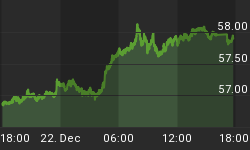As we stated last November:
"In A Short History of Financial Euphoria, John Kenneth Galbraith observes: "All crises have involved debt that, in one fashion or another, has become dangerously out of scale in relation to the underlying means of payment." We have now reached this 'Minsky Moment.' According to Morgan Stanley, the risk is now greater than 50% that the financial system "will come to a grinding halt." In this Bloomberg video, Gregory Peters, head of Credit Strategy for Morgan Stanley, describes the process of securitization, which "has created this cheap financing environment," as "broken." Goldman Sachs chief, U.S. economist Jan Hatzius, estimates that lending will be curbed by $2 Trillion (Ed Note: Reuters link from original not found, replaced with Business Week article). The last time the economy had to endure this kind of systemic shock was 1930:
"Several brokerage houses tumbled; blue-sky investment companies formed during the happy bull market days went to smash, disclosing miserable tales of rascality; over a thousand banks caved in during 1930, as a result of marking down both of real estate and of securities; and in December occurred the largest bank failure in American financial history, the fall of the ill-named Bank of the United States in New York." (Only Yesterday: An Informal History of the 1920's by Fredrick Lewis Allen)
Here's what investors should do:
First: Protect Principal
To protect against investment losses, investors should sell assets and hold cash. As credit tightens, cash rises against leveraged assets (or assets fall). This occurred dramatically in the credit busts of the 1930s, 1880s and 1840s. When we state 'cash' we specifically mean U.S. Treasury Bills. There are many other financial alternatives touted as cash but these should be avoided. No private insurer, corporation, or institution can compete with the full faith and credit of the United States Government. Investors should especially stay clear of money market funds which include asset-backed commercial paper.
Second: Reduce Barriers To Ownership
Complex arrangements weaken ownership claim. Remember with any fund, investors own shares of the fund not the underlying asset. Theoretically, even money market funds labeled 'U.S. Government-only' can halt share redemptions if the fund family is having problems.
Third: Be Very Discriminating Where Funds Are Kept
Investors should select brokerage firms that are financially healthy, have historically few customer legal disputes, and have no investment banking department. Using these criteria, it is now becoming evident that Wall Street firms and online brokerages are ill-prepared to act as a haven during a bear market.
It's Better NOT To Need Insurance
The Securities Investor Protection Corporation insures accounts up to $500,000 ($400,000 securities, $100,000 cash). However, its reserve fund is only $1.4Billion. The SIPC also has the ability to borrow $1B from a consortium of banks (assuming they aren't the ones in trouble!) and $1B from the Treasury department. Compare $3.4B in total SIPC insurance to the Royal Bank of Scotland's estimate of $250B to $500B in losses from this credit crisis. Is this an apple to oranges comparison? Not hardly, both customer securities and Level 3 assets are the financial institution's assets (Clarification- 9/17/2008: The client pool is segregated from the other assets of the firm. But the client does not retain full ownership of the securities.). It's no wonder that when we spoke with the SIPC's legal department they are warning 'over-the-limit' investors to "do their due diligence when selecting a brokerage."
Some brokerage firms have additional account insurance from the Customer Asset Protection Company ("CAPCO"). According to Standard and Poor's rating service, CAPCO "relies on highly rated reinsurers for remotely possible extremely large losses." In the latest S&P report, 'remotely possible' and 'extremely remote' are used quite frequently in describing a probable maximum loss (PML) or "when one brokerage firm loses 0.20% of customer assets." But how much is really held in reserve or arranged through reinsurers to back accounts if the worst were to occur? "CAPCO's management maintains the confidentiality of its financial statements." Even worse, questions for more information are directed to 'participants' or the brokerages themselves. What we do know is that reinsurers are dealing with losses of their own. Our conclusion is that investors should not rely on bailouts from insurance companies and should instead move funds immediately to more secure financial institutions. Even if an insurance company was able to pay, who wants the headache of dealing with the claims process?"
(End of the Investment Analysis Report From November)
Addendum
To this report from last November, we can add this summer's search for a smarter alternative to money market funds, as well as a description of a more secure financial institution. With the first money market fund 'breaking the buck' since 1994, we expect nervous investors to be looking for alternatives. We will publish the sequel to Crash Opportunities, Part One (published two weeks ago), when the meltdown pauses. In the meantime, if you are interested in principal protection for your portfolio, please contact us.
***No graph, chart, formula or other device offered can in and of itself be used to make trading decisions.















